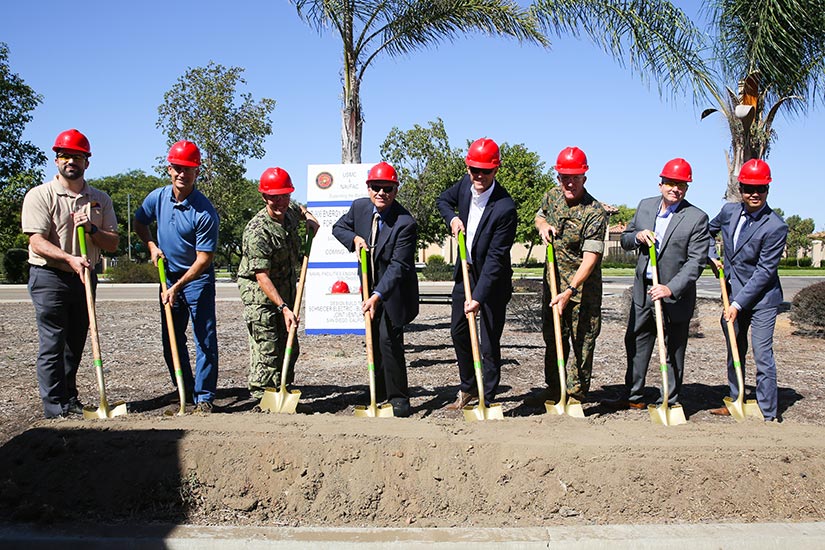Marine Corps Air Station Miramar and NREL: Allies in Energy Efficiency, Systems Integration, and Resilience
For Miramar's Latest Energy Management Mission, on-the-Ground Champions and Energy Experts Partnered To Build a New Efficient, Resilient, and Cost-Effective Data Center

A U.S. Marine Corps F-35C Lightning II lands at Marine Corps Air Station Miramar. Photo by Sgt. Dominic Romero, U.S. Marine Corps
It was a hot and muggy day—August in Tampa—but Marine Corps Air Station (MCAS) Miramar Energy Manager Mick Wasco's focus was on fresh ideas for data center design. Wasco was at the 2017 U.S. Department of Energy Federal Energy Management Program (FEMP) Energy Exchange, a premier week-long professional development event for the federal energy and water management community. Otto Van Geet, principal engineer for labs and data centers at the National Renewable Energy Laboratory (NREL), was speaking about the latest research and best practices for data center efficiency.
Wasco was inspired and excited. "I was sending the slides to [Project Manager Armando Romo] saying, "We have to implement this in our new data center project,'" he said. It was the start of a new chapter in NREL and MCAS Miramar's long, positive partnership.
Long-Time Allies
Even before the latest data center project, MCAS Miramar was an energy and water security leader within the Department of Defense. NREL has been a partner for over a decade in enhancing its resiliency, energy efficiency, and integration of renewable energy, having helped develop and implement MCAS Miramar's installation-wide microgrid including solar arrays, future battery storage system, and on-site landfill-gas power plant incorporating fossil fuel generators. If needed, MCAS Miramar can support over 100 mission-critical facilities while decoupled from the grid for weeks at a time and has the ability to seamlessly test the system in various training scenarios.

NREL and Raytheon performed system-level testing for MCAS Miramar on a simulated microgrid at NREL’s Energy Systems Integration Facility in 2014. Photo by Dennis Schroeder, NREL
MCAS Miramar has won multiple Secretary of the Navy Energy Excellence Awards and received recognition from organizations including FEMP, the U.S. Environmental Protection Agency, and the San Diego County Water Authority for its efficiency, conservation, and resilience efforts.
A New Mission
After a series of successful energy projects, MCAS Miramar was targeting data center energy efficiency and design—a big opportunity for federal facilities as efficiently cooling the large numbers of computer systems can offer tremendous energy and water savings. Additionally, energy efficiency is one of the three pillars of the U.S. Department of the Navy's Energy Security Framework to support mission readiness.
An industry-preferred metric for measuring infrastructure efficiency for data centers is power usage effectiveness (PUE)—the ratio of a facility's total power use to the power used by its computing equipment. A "perfect" data center would have a PUE of 1.0. Across data centers overall, average PUE hovers around 1.8. Data centers focusing on efficiency typically seek to achieve PUE values of 1.2 or lower.
NREL was perfectly poised to assist MCAS Miramar in its new endeavor. In addition to Van Geet's world-class team of data center energy researchers, NREL has experience designing, building, and operating its own high-performance data center—designed to be one of the most energy efficient data centers in the world—which operates with an annual PUE of less than 1.04.

An enduring partnership: MCAS Miramar broke ground on its microgrid in 2017 after working with NREL on system design and testing. Image from Sergeant Brytani Musick, U.S. Marine Corps
Ambitious Ideas Take Flight
Van Geet and commercial buildings research engineer Shanti Pless hosted MCAS Miramar's prime contractor at NREL's Golden, Colorado, campus to share ideas and review early data center designs. The visit kicked off with a tour of duty—er, data—at NREL's high-performance computing data center.
The visit assured MCAS Miramar's design team they could be more ambitious with energy efficiency targets using data center best practices. These included arranging servers and racks in a hot aisle/cold aisle layout, where server racks line up in alternating rows so that cold air intakes and hot air exhausts face opposite directions. Cooled air is targeted at the front of the rack—where the intakes are located—and warmed air is directed out the back of the equipment into the hot aisle. Other examples of best practices included using ambient air to maximize free cooling and designing an efficient cooling system. Another notable innovative design choice was to use recycled water for the water-cooled system, as potable water is a critical resource in the San Diego area.

MCAS Miramar server racks line up in alternating rows so that cold air intake and hot air exhausts face opposite directions. Photo from R.A. Burch Construction
"In early conversations, the Miramar team was pushing back, thinking the best they could do was a PUE of 1.8," Van Geet said. "In working with Mick and ultimately with the design team, we determined a PUE of 1.2 should be achievable and it went into contract documents. It could offer significant operating cost savings over the life of the facility."
Design team member Rob Bodenhamer of Vasquez Marshall Architects agrees the meetings helped define the project: "Our visit to NREL inspired our design-build team to creatively integrate energy-efficient design options, validated our design direction for achieving optimal PUE efficiency, and ultimately resulted in our meeting the specified goal of a 1.2 PUE."
"Our visit to NREL inspired our design-build team to creatively integrate energy-efficient design options, validated our design direction for achieving optimal PUE efficiency, and ultimately resulted in our meeting the specified goal of a 1.2 PUE."
— Rob Bodenhamer, Vasquez Marshall Architects
The energy cost savings from this more ambitious efficiency goal could be used by the Department of the Navy and MCAS Miramar to fund other energy resilience efforts in alignment with federal legislation such as 10 U.S. Code § 2912-Availability and use of energy cost savings.
NREL electrical engineers made another suggestion that changed the shape of the project—leverage the building's 2-megawatt (MW) backup diesel generator, previously planned to serve just the data center, as an asset for the entire installation by integrating it with the installation's microgrid. This way, the generator could be better utilized during contingency operations while boosting resiliency and supporting other facilities at MCAS Miramar.
Performance-Based Design: Integrating Energy Targets at Zero Dark Thirty
Van Geet and Pless suggested the data center project could be a good opportunity to use performance-based design-build, a strategy to integrate energy performance requirements early on in building design. The process is founded in the idea that deep and cost-effective energy savings are possible—even with typical construction budgets—when these goals are placed front and center in the concept design, requests for proposals, budgets, and planning.
NREL has used an integrated design-build approach for all of its own new buildings since 2010, when it pioneered the practice in designing the federally owned Research Support Facility on its Golden, Colorado, campus.
Van Geet is a longtime advocate of the approach, as it results in a more integrated design.
"You leave it to the design team to work with the build team to figure out how to meet energy and sustainability performance goals, size, and mission requirements without prescribing the details," Van Geet said. "The design-build team works together to figure out how to do that best, at no more cost, and faster, with fewer change orders. It makes the whole process more streamlined."
MCAS Miramar liked the idea. They crafted a performance-based design-build contract that incorporated requirements for a measured data center PUE of 1.2 and for the building's backup diesel generator to also be able to supply power to the base's microgrid during outages in addition to providing backup power to the data center.

A Decisive Victory
The data center was commissioned and turned over to MCAS Miramar in the summer of 2020. Advanced metering infrastructure system testing indicates the target PUE of 1.2 was achieved.
The microgrid-connected data center generator is also providing an additional 1.5 MW of power to the entire installation when isolated from the utility. According to project engineer Kurt Wittman of MacDonald Engineers, Inc., "From concept to incorporation and testing, the data center diesel engine generator and closed transition interface with the installation's microgrid in island mode was quite a challenge but concluded with complete success."
"NREL helped us at every step of the way, and for many other reasons combined, I think this is one of the best military construction projects we’ve done in terms of innovation."
— Mick Wasco, Utilities & Energy Management, MCAS Miramar
MCAS Miramar's Mick Wasco is very pleased with the results of the continued partnership with NREL. "Without any hesitancy or question, NREL helped us at every step of the way, and for many other reasons combined, I think this is one of the best military construction projects we've done in terms of innovation."
Rachel Shepherd, leader of the FEMP data center efficiency program, applauded the results. "It's great to see that Miramar is leading the way in the federal government for new data center design requirements and performance."
Achieving Your Energy Resilience Mission
NREL research supports performance-based design for efficient facilities and data centers, a tremendous opportunity for energy and cost savings in the federal sector.
NREL also supports energy efficiency, resilience, and the life cycle of microgrid project development including feasibility assessments, financial analyses, conceptual designs, project oversight, commissioning support, and demonstration. NREL has provided technical expertise to support the U.S. Department of Defense and many other partners with microgrid resiliency efforts. Learn more about partnering with NREL.
Last Updated May 28, 2025
